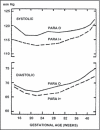ASH position paper: hypertension in pregnancy
- PMID: 19614806
- PMCID: PMC8673190
- DOI: 10.1111/j.1751-7176.2009.00085.x
ASH position paper: hypertension in pregnancy
Abstract
The American Society of Hypertension is publishing a series of Position Papers in their official journals throughout the 2008-2009 years. The following Position Paper originally appeared: JASH. 2008;2(6):484-494. Hypertension complicates 5% to 7% of all pregnancies. A subset of preeclampsia, characterized by new-onset hypertension, proteinuria, and multisystem involvement, is responsible for substantial maternal and fetal morbidity and is a marker for future cardiac and metabolic disease. This American Society of Hypertension, Inc (ASH) position paper summarizes the clinical spectrum of hypertension in pregnancy, focusing on preeclampsia. Recent research breakthroughs relating to etiology are briefly reviewed. Topics include classification of the different forms of hypertension during pregnancy, status of the tests available to predict preeclampsia, and strategies to prevent preeclampsia and to manage this serious disease. The use of antihypertensive drugs in pregnancy, and the prevention and treatment of the convulsive phase of preeclampsia, eclampsia, with intravenous magnesium sulfate is also highlighted. Of special note, this guideline article, specifically requested, reviewed, and accepted by ASH, includes solicited review advice from the American College of Obstetricians and Gynecologists.
Figures
References
-
- Ness RB, Roberts JM. Epidemiology of Hypertension. In: Lindheimer MD, Roberts JM, Cunningham FG, eds. Chesley’s Hypertensive Disorders in Pregnancy. 2nd ed. Stamford, CT: Appleton & Lange; 1999:43–65 (3rd edition revision in press, May 2009, Elsevier).
-
- Villar J, Say L, Gulmezoglu AM, et al. Pre‐eclampsia Eclampsia: a Health Problem for 2000 years. In: Critchly H, MacLean A, Poston L, Walker J, eds. Pre‐eclampsia. London, England: RCOG Press; 2003:189–207.
-
- Zandi‐Nejad K, Luyckx VA, Brenner BM. Adult hypertension and kidney disease: the role of fetal programming. Hypertension. 2006;47:502–508. - PubMed
-
- Sibai BM. Preeclampsia as a cause of preterm and late preterm (near‐term) births. Semin Perinatol. 2006;13:16–19. - PubMed
Publication types
MeSH terms
Substances
LinkOut - more resources
Full Text Sources
Medical
Research Materials
Miscellaneous


